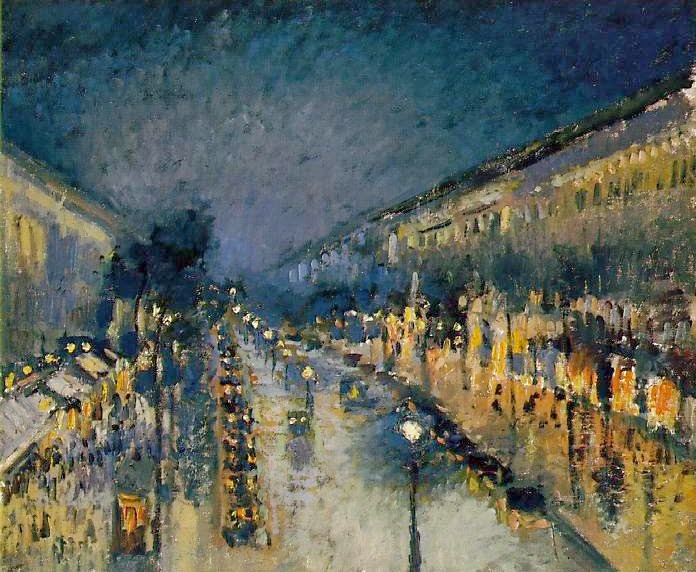Boulevart Montmartre by Night - 1897
National Gallery - London - U.K.
Camille Pissarro 1830 – 1903) was the leader of the a French Impressionist movement. Born on the island of St Thomas (today US Virgin Islands) his father was a french merchant, a portuguese descendent jew, who immigrated to the island to deal with business affairs. When Camille was twelve his father sent him to France in order to continue his studies. In Paris he worked as assistant to Danish painter Anton Melbye and studied paintings by other artists whose style impressed him: Courbet, Charles-François Daubigny, Jean-François Millet, and Corot.
Although initially Pissarro painted according with the standards at the time in order to be displayed at the Paris Salon, (the official body whose academic traditions dictated the kind of art that was acceptable) soon he started to show his own tendencies sharing with his master Camille Corot, who tutored him an interest on rural scenes painted from nature. With Corot, Pissarro was inspired to paint outdoors, also called "plein air" painting. Pissarro later explained the technique of painting outdoors to a student: ”Work at the same time upon sky, water, branches, ground, keeping everything going on and equal basis and unceasingly rework until you have got it. Paint generously and unhesitatingly, for it is best not to lose the first impression.”
Cézanne would later called him “the first Impressionist”. In 1873 he helped establish a separate collective, called the "Société Anonyme des Artistes, Peintres, Sculpteurs et Graveurs," which included fifteen artists like Cézanne, Monet, Manet, Renoir, and Degas. Pissarro created the group’s first charter and became the “pivotal” figure in establishing and holding the group together. With a youthful temperament and creativity Pissarro gave wings to imagination, turning up side down the way people saw nature's depiction setting up with his pears what was known as the "Impressionist Movement".
By the 1880s, Pissarro began to explore new themes and methods of painting in order to break out of what he felt was an artistic “mire”. As a result, Pissarro went back to his earlier themes by painting the life of country people, which he had done in Venezuela in his youth. Degas described Pissarro’s subjects as “peasants working to make a living”. This period also marked the end of the Impressionist due to Pissarro’s leaving the movement and the begin of a decade with influences from Georges Seurat and Paul Signac, which led to Pissarro's Neo-Impressionism.
It was by the end of the 80's that Pissarro decided to rent a room in the Grand Hôtel de Russie, on the corner of the Boulevard des Italiens and the Rue Drouotin, in Paris. From his bedroom window he'd lookout of the left of his window onto one of Paris’s grandest boulevards. He had come here specifically to paint a series of Parisian views, of the Boulevard Montmartre, at different times of the day partly because his eyesight was falling, and painting out of doors was being increasingly difficult.
This particular picture shows the boulevard in the evening. As with the whole 14 paintings series, the strong central shape of the receding boulevard, flanked by rows of trees and impressive buildings, dictates the simple, powerful composition and perspective, given drama by the high viewpoint. Strong brushstrokes on the sky and roas help to draw the eye down this busy thoroughfare. Sketchily painted figures and carriages, like blurred photos, add a bustling movement, although the effect of pearly winter sun diffused through mist makes this view calmer than some of the others. In many places, such on a road surface, a broad pointillism is used.
Pissarro had previously experimented with this technique, and abandoned it, but its influence remains. By the 1890’s Pissarro felt that series paintings such as this gave him the artistic direction he craved. They showed that his heart was in exploring the changing light and weather effects found all around us – a major impressionist preoccupation.
Source: Ann Kay, net, wikipedia
Four views of the Boulevart Montmartre, taken in different hours of the day - 1897 (Image take here)


Sem comentários:
Enviar um comentário